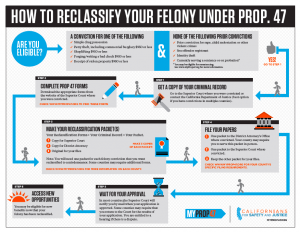Historic Opportunity
Prop. 47 is the largest opportunity in U.S. history for people to change past felony convictions on their records. As many as 1 million Californians may be eligible.
**The record change process (also known as reclassification) is for individuals with a qualifying low-level, nonviolent felony on their criminal record. It does not apply to individuals who are currently serving a sentence in prison or in jail, or currently on probation. There is another process, known as resentencing, for those individuals. Click here for more information on the resentencing process.**
 The following steps below outline the record change (reclassification) process. You can use our reclassification infographic as a handy guide to follow the steps needed to change your record. The infographic is also available in Spanish.
The following steps below outline the record change (reclassification) process. You can use our reclassification infographic as a handy guide to follow the steps needed to change your record. The infographic is also available in Spanish.
Events are being held across the state where trained staff will be available to assist you in starting the record change process. For a listing of upcoming events, please click here.
Determine Your Eligibility:
If you have a felony record in California for one or more of the following low-level, nonviolent offenses – no matter how old the conviction – you may be eligible to have your record changed from a felony to a misdemeanor for these offenses:
- Simple drug possession
- Petty theft under $950
- Shoplifting under $950
- Forgery under $950
- Receipt of stolen property under $950
- Writing a bad check under $950
Note: If you are currently serving a sentence for one of the above offenses, you may qualify for resentencing. Click here for more information on the resentencing process.
If you have a previous conviction for crimes such as rape, murder or child molestation, or are in the sex offender registry, you will not be eligible to get the six felonies listed above reclassified. Click here for a full list of crimes that will exclude you from getting your record changed under Proposition 47.
STEP 1: GET A COPY OF YOUR CRIMINAL RECORD
You will need a copy of your “RAP Sheet” (criminal record) to determine if you are eligible and have no excluding offenses. If your conviction(s) are from one county, visit the Superior Court where you were convicted and obtain your record.
STEP 2: COMPLETE YOUR PROPOSITION 47 RECLASSIFICATION FORMS
In most counties, you will need to complete two documents:
1) an Application for Reclassification (record change)
2) Proof of Service. Click here to look up the specific forms used in your county.
STEP 3: MAKE YOUR RECLASSIFICATION PACKET(S)
Your completed Reclassification forms are your reclassification packet. You will need to submit a separate reclassification packet for each conviction you would like to have reclassified.
Make three copies of each reclassification packet:
1) Original for your records.
2) One copy provided to the District Attorney’s Office.
3) One copy filed in the Superior Court where you were sentenced.
Some counties may require you to complete additional paperwork. Click here for specific information by county.
STEP 4: FILE YOUR RECLASSIFICATION PACKET
- One packet will go to the District Attorney’s Office where you were convicted.
- One packet to the Superior Court where convicted.
- Keep the packet of original papers for your files.
For the address of the District Attorney and Superior Courthouse in your county, click here.
STEP 5: WAIT FOR APPROVAL
After submitting your forms, the District Attorney’s Office will review your application to determine if you are eligible to have your felony reduced to a misdemeanor. If the District Attorney’s Office confirms your eligibility, they will then notify the Superior Court. In most counties, you will be notified by mail once the Superior Court has recorded the reclassification. Some counties may require that you return to Court to learn the status of your application.
Typically, a hearing is not needed to process your record change. However, if there is a dispute and your application is denied, you will be entitled to a hearing. In some instances, it may be that your forms were completed incorrectly, which is why working with an attorney or legal clinic is so important. If you qualify, a public defender will represent you at this hearing.
STEP 6: ACCESS NEW OPPORTUNITIES
Once your felony has been removed from your record, you may be eligible for a variety of benefits and opportunities afforded to other Californians, including but not limited to: professional licensing for various trades, student loan eligibility, housing benefits, holding government office and serving on a jury. Click here for a list of resources that can assist you.
